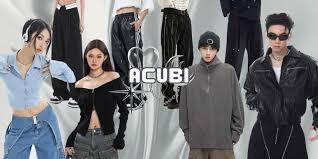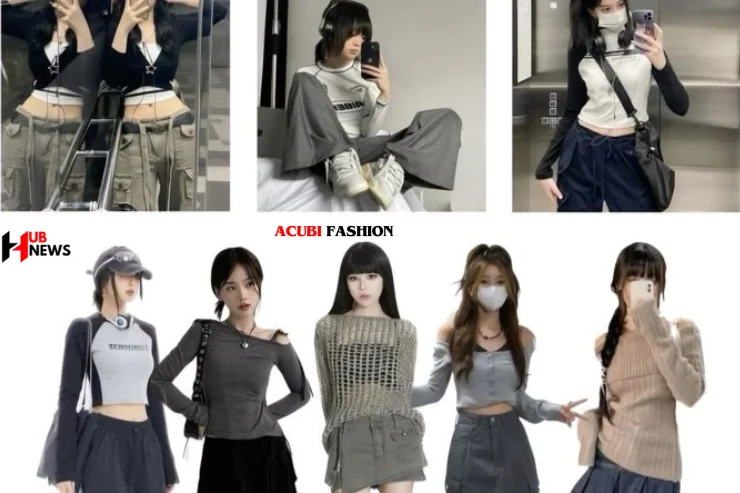The Rise of Acubi Fashion: A New Minimalist Language
Acubi fashion began as a subtle streetwear trend in South Korea. It quickly evolved into a global style movement. At first glance, Acubi looks simple—oversized silhouettes, neutral colors, sheer layers—but it carries a powerful message. Acubi doesn’t shout; it speaks quietly with intention. In a time where loud trends dominate fast fashion, Acubi Fashion offers an escape through calm, controlled styling. It doesn’t follow the rules of flashy trends or seasonal cycles. Instead, it offers a timeless, personal way to dress. American fashion lovers, especially Gen Z, have embraced Acubi’s muted tones and relaxed vibe. They crave authenticity and comfort, and Acubi delivers both.

Minimalism Redefined: From Western Luxury to Korean Streetwear
Minimalism in the West often comes from luxury brands. Think Calvin Klein’s clean tailoring or The Row’s neutral palettes. These brands focus on form, quality, and sophistication. Acubi changes that. It’s less about polished perfection and more about expressing emotion through form. Acubi doesn’t need structure or rules. It uses layered mesh, asymmetrical cuts, and loose silhouettes to create movement. Where traditional minimalism values precision, Acubi values imperfection. This shift attracts young Americans who want to break away from fashion standards and explore something more personal, freer, and raw.
The Visual Code of Acubi Style
Acubi fashion has a distinct visual language. It favors earthy and neutral tones—black, beige, white, gray, and sometimes dusty blue or olive. The silhouettes remain loose, flowing, and genderless. You’ll see asymmetry in cuts, extra-long sleeves, high-waisted trousers, and layered tanks over sheer shirts. Footwear usually stays minimal: chunky sneakers or sleek loafers. Jewelry is subtle—thin silver chains or simple earrings. Every piece feels intentional. Even when the look seems undone, it tells a complete story. That’s the beauty of Acubi—it feels casual but never careless. It’s art you can wear every day.
Gender-Fluid Fashion for a New Generation
Acubi fashion doesn’t belong to any gender. Its oversized cuts and neutral palettes remove the need for labels like “men’s” or “women’s.” In a world where many young people challenge gender norms, Acubi offers a perfect platform for self-expression. Anyone can wear it, no matter their identity. It focuses on how clothes make people feel rather than how they “should” look. In America, this mindset is growing fast. More people reject rigid gender norms in fashion. Acubi aligns with their beliefs by giving them the freedom to express themselves without judgment or limits.
The Role of Social Media in Acubi’s Growth
Social media platforms, especially TikTok and Instagram, helped Acubi grow. Influencers, stylists, and everyday users began sharing their #acubifits online. These posts often go viral because the outfits look effortless but aesthetic. Tutorial videos break down how to build an Acubi outfit using thrifted pieces, basics, or Korean brands. Gen Z creators focus on self-expression, not following traditional fashion guides. This approach aligns perfectly with Acubi’s message. It’s no surprise that American teens and young adults now see Acubi as both a fashion choice and a lifestyle. It represents peace, clarity, and purpose in a chaotic world. Hubnews
Emotional Dressing: Acubi and Inner Peace
Acubi fashion carries emotion in every layer. It connects fashion to mental health in a way that feels fresh and honest. Wearing Acubi is about dressing for how you feel, not for trends. Loose-fitting clothes provide comfort. Muted colors calm the senses. The unstructured silhouettes remove the pressure to look “perfect.” Many fans say Acubi outfits help them feel grounded and balanced. In a high-pressure world, especially in American cities, this emotional comfort matters. Acubi doesn’t just change how people look. It changes how they feel—and that makes it powerful.
Sustainability and the Slow Fashion Shift
Acubi supports a slower, more thoughtful way to dress. Its minimalist foundation encourages people to buy less and wear more. A typical Acubi wardrobe includes timeless staples—wide-leg trousers, neutral blouses, mesh tops—that pair well together. This encourages repeat use instead of constant buying. Many fans shop secondhand or support small Korean designers. They avoid fast fashion whenever possible. In America, this mindset is growing. More young people want sustainable fashion that aligns with their values. Acubi, with its quality-focused approach, fits right into the slow fashion movement.
American Retailers Take Notice
American brands and retailers have started responding to Acubi’s influence. Stores like Urban Outfitters, Zara, and H&M now feature more muted, loose-fitting collections inspired by Korean streetwear. Some labels go further by collaborating with Korean designers or curating entire “K-style” lines. Independent U.S. brands also adapt Acubi elements—soft palettes, asymmetry, unisex sizing—to attract younger audiences. These moves prove that what is Acubi fashion isn’t just a passing phase. It’s shifting how American brands think about minimalism and streetwear. The future of fashion might not be louder—it might be softer, calmer, and more expressive.
Cultural Blending: East Meets West
Acubi fashion shows how cultures can inspire one another without copying. It brings Korean streetwear into American wardrobes, but it doesn’t lose its identity in the process. Instead, it blends with local styles. In New York, you’ll see Acubi worn with denim or vintage American boots. In Los Angeles, fans add skatewear or retro sunglasses. This fusion creates a new kind of minimalism—one rooted in emotional expression and cultural exchange. It’s fashion with depth. It respects its origins while making space for personal interpretation. That’s why it continues to grow across borders.
The Future of Acubi in American Fashion
Acubi isn’t going anywhere. Its rise reflects a deeper change in how people think about clothing. Americans want more than trends. They want meaning, comfort, and flexibility. Acubi offers all three. As more people embrace sustainability, emotional wellness, and identity freedom, Acubi will keep evolving. It gives wearers tools to express themselves without speaking loudly. The future of fashion might not be covered in logos or colors—it might be soft, quiet, and intentional. Acubi is leading that future, one layered look at a time.



